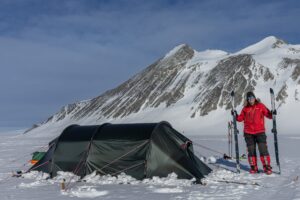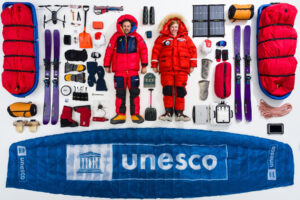Although I’ve done many expeditions to both the North and South Poles, both as an independent traveler and a guide, every fresh trip brings up new gear ideas. There are also old, tried-and-true standards that I have used for years. As I begin the South Pole season, let’s take a look at my gear. Today: Ski bindings for polar travel.
One note: Proper gear is just one aspect of polar travel. Developing skills, planning and logistics, understanding the polar environment, and knowing how to minimize risk are all equally important. If you would like to fast-track your development as a polar traveler, consider hiring an IPGA Polar Expedition Guide.
Cable bindings
On my first South Pole expedition, we used One Sport boots with Rottefella Riva cable bindings (similar to the ones below).

Photo: Eric Philips
The toe piece on all our boots came apart and the side walls of our bindings broke. The next models had a crossbar from wall to wall which solved this problem, such as G3 Targa that we used in Patagonia in 2000.
Nobody seems to use cable bindings on polar expeditions anymore, despite Baffin and Alfa making compatible boots.
Three-pin bindings
I’m sure there are some people who have not been introduced to the three-pin binding system, having jumped straight to cable, backcountry (BC), or Flexi bindings (though cables actually predate three-pin by many years).
Three-pin bindings were very common and are still used by some diehards. I used them on my Ellesmere Island expedition in 1992 and maybe even my Greenland crossing in 1995. Two clients used them when I guided the route from the Messner Start to the South Pole for ALE in 2007-08.

A three-pin binding. Photo: Eric Philips
The holes in the underside of the toe would fill with snow which, when engaged into the pins and clamped down, would turn to ice and remain in the steel insert within the toe. Subsequent entries meant more icing and a deteriorating engagement between pins and plate. They would catch only the rubber part of the toe which would eventually rip out. After a few tears, the rubber would become too damaged and the system would ultimately fail.

Rubber ripping as a result of the three-pin binding system. Photo: Eric Philips
Manufacturers started adding cables to the three-pin system, which was an improvement but added a layer of complexity. Baffin still has holes in the toe of their Guide Pro models.
The Salomon Nordic System (SNS)
Salomon introduced the SNS binding sometime in the 1980s. Their Profil model was the first straight bar integrated into the toe of the boot. They later introduced a heavier version for backcountry, but NNN (New Nordic Norm) became more popular and their BC model became somewhat of a backcountry standard.

The SNS binding.
It is still used widely today but the mechanism is very prone to clogging with ice and I have seen some clamp mechanisms break. There is a manual and step-in version and of course, it requires a dedicated (and very expensive) boot. Alfa A/P/S is the standard polar-climate boot for this binding.
This kind of binding with the pivot point forward of the toe and a rubber flexor to create forward momentum of the ski encourages a more classic Nordic ski style rather than a plod. However, there are so many factors that will bring a manhauling skier using this system back to a plod.
Flexi bindings
Following consistent failures with boot/binding combinations of the 1990s, I added to the mix with the first prototype of Flexi bindings.

I first used these while skiing from Russia to the North Pole with Jon Muir in 2002. I modeled it on a snowboard binding, using straps rather than toe pieces or cables to secure the boot to the binding. This completely eliminated any toe connection.
Flexis were originally designed for use with Baffin winter boots, but they work with any boot, Alfa included. Like the pioneering yet fragile Berwin binding, early models broke at the flex point. I didn’t see consistency until I started using UHMWPE plastic on the base plate. Even then, we had some failures. These have been completely eliminated since I re-engineered the entire binding in 2014.

The Flexi binding in action. Photo: Eric Philips
These bindings are heavier and not very pretty but they will survive any Arctic Ocean expedition at -50°C, the ultimate test of any polar equipment. Some people will argue that they’re slow, but I can pull up stats that suggest otherwise.
New binding?
Finally, let’s consider a potentially interesting new model, the Rottefella Xplore. Currently, these don’t seem to be an option for polar expeditions because there are no suitable boots yet. It has 70mm of connection between the boot toe and binding, NNN BC has 42mm and three-pin has 33mm, so it seems Xplore is already designed for backcountry.

But is it polar-rated? It concerns me that the system relies on internal spring pins on either side of the boot toe, perhaps vulnerable to icing up and malfunction, particularly after a dunking through thin ice on the Arctic Ocean.

The binding itself might be less prone to the icing up common in NNN BC (which can ultimately lead to failure of the mechanism), but the binding release relies on a potentially vulnerable spring. The exchangeable flexor appears to be difficult to replace or service in the field. Xplore is super light, maybe a red flag? However, I will keep an eye on this promising system.
Heel risers
Despite their usefulness, heel risers (also called climbing wires) are not common on polar expeditions. They’re typically used for skinning or snowshoeing up slopes to reduce overextension of the Achilles’ tendons. This also relieves the calves.
Hauling a heavy sled creates the same angles, so it makes sense to relieve the stress with heel risers. In 1998, we each started with 190kg, skiing from Ross Island to the South Pole, and the risers were excellent. Judging by my photos, we used them a fair way across the Ross Ice Shelf. We also used them in Patagonia, but mainly for the slopes, as we do on our Aussie snowshoe trips.

Heel risers in action. Wade Fairley hauls his laden kayak up a glacier in Patagonia, September 2000. Photo: Eric Philips
When no longer required, the riser is simply folded away. For the sake of an extra few grams, they’re a worthy addition if you’re hauling a heavy sled.





